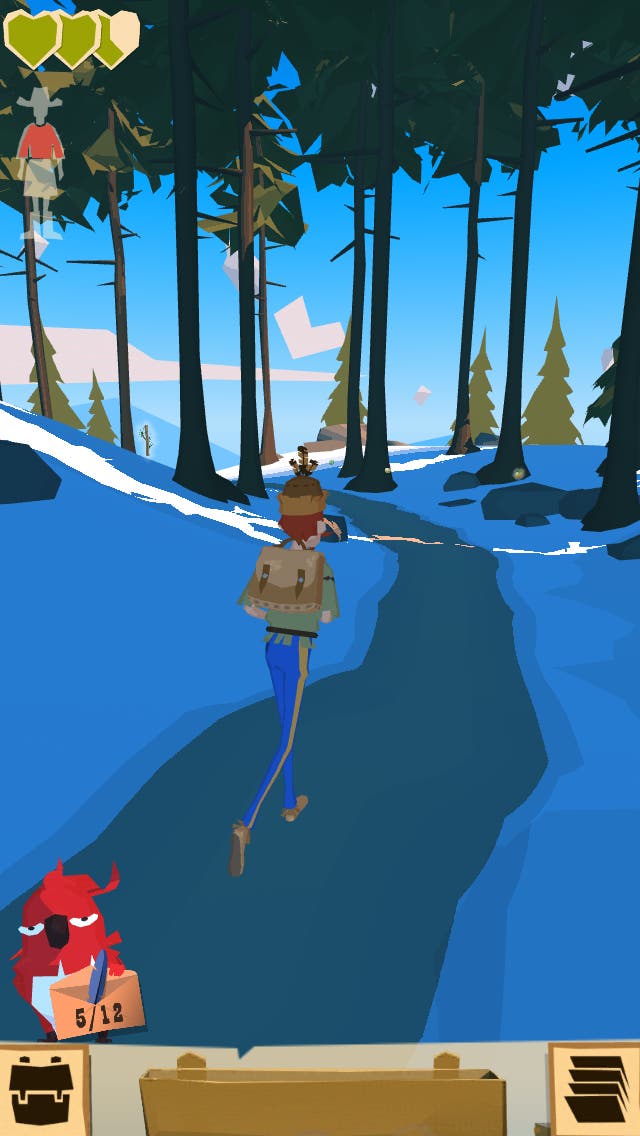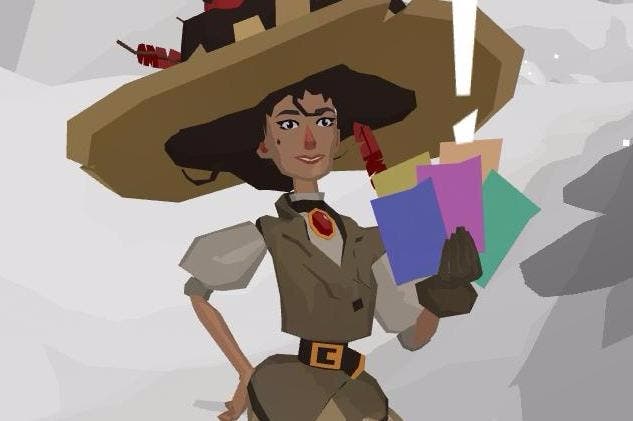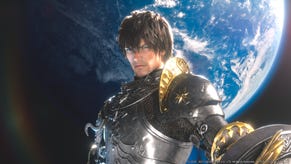Molyneux's new game doesn't always seem to know what it's good at
The Trail is fascinating and weird.
At the top of a hill I stopped amongst the narrow pines and falling snow to sit through an advert for a Clash of Clans knock-off. When it had ended, and I'd taken my reward, I spent a moment or two watching as the sky changed colour. I couldn't see much of the sky from where I was stood, but I saw it all play out on the ground regardless. A cloud shifted away from the sun, perhaps. A shadow receded and the sandy path before me started to glow with light. I've seen these things in the real world - the sudden, eerie, appearance or disappearance of the sun and the stage-management effect it has on the world lying all about - and I've seen it in films, very occasionally, and only when Terrence Malick, who cares about such things, is at the helm. I've never seen it in a game, though.
At heart, I think The Trail wants to be a game about returning to nature, and witnessing all the strange, quiet tricks that nature can sometimes play. It's a beautiful game, and at times it's also the strange, difficult, game that I often suspect it truly wants to be. But it doesn't always work out that way. I moved on from that hill, and nature receded, buried under dull quests, dull collecting, dull crafting, dull invitations to watch dull adverts for dull games. It's not that The Trail is not what I hoped for, because I could always just adjust my expectations accordingly, and I believe in meeting games on their own terms anyway. It's that, weird and presumptuous as this is, I really don't think The Trail is what its creators thought it could become: it doesn't feel like they have finalised its terms. Not yet, anyway. You have to hunt for what's great about it, and while it's definitely there, it's often buried.
God, it sounds so lovely. You're off on foot across the wilderness, taking in the sights that are rendered in lovely flat-colours and fidgety natural shapes, bathed with Golden Age railway poster lighting. The sights are worthy of this treatment, too: creamy cliffs, snow-edged mountains of grey slate, lustrous valleys swaying with dandelions while stone arches ease over the path. You're fixed on a track, and your only control of your character for the most part is how fast they move, but that's no problem when you can spin the camera around you and take it all in, all of it so pretty, all of it already receding, beauty on a plodding conveyor belt with the added poignancy that you can't seem to turn around and immediately reclaim anything that's passed you by.

This part of The Trail is lovely - really, really lovely - and it's a reminder that any team with Molyneux at the top of the org charts is always going to do something that's touched with wayward brilliance. But as you play, as you pad along that track sometimes passing other players, you can quickly start to sense the voices that must have been heard at some point during the game's conception, picking away at the unadorned glory of it. "But what do you actually do?" Fair enough question, and not being a game designer I'm not going to venture an answer. And perhaps: "How do we make money?" But that, it turns out, is not as intrusive as the things that have been invented to answer the first question.
What you do, since this is 2016, is crafting. Actually, what you do is collecting and then crafting. As you wander along the countryside, you see glowing objects by the side of the track. Whip a finger across the screen and drop these woodland gems into your pack - a nice feel to it, granted - and then keep your eyes bright for more of them.
These things stack up - stones, bits of rag perhaps, apples, pine cones, sticks - and eventually your pack becomes full. Then you come across a campfire, which is good news because your stamina has been falling as you've walked, and at the campfire, as your heart meter tops up again, you get to craft things from the stuff you've found. Axes for chopping trees. Shoes for making you walk faster. Hats - The Trail is aggressively pro-hat - for giving you more stamina. Any bits left you can either sell in a mini-game or craft into things to then sell at the same mini-game for slightly more money. Oh and hang onto some it, maybe, because everything in this world is just itching to fall apart and need replacing.

The selling mini-game is quite clever, since the longer an item remains up for grabs, the more the value of it falls, and there's a reward for whoever makes the most money overall. It's also delivered in an arrestingly odd way: you toss your items onto a conveyor belt that chugs towards a sort of rock-smashing wheel that eventually chews down anything unbought and offers a small payment.
This is the game's loop, or it's the loop from the handful of hours I've put into it. Walking between campfires, collecting and then crafting stuff that makes you better at walking between campfires, all the while earning money and taking on crafting quests to expand your overall possibilities. Oh, and perhaps toying with the idea of dropping real money on the inevitable second in-game currency that gives you access to the really valuable items the game has to offer. At some point I was granted a map, which allowed me to journey back to previous campsites, perhaps to snag locally-available resources. Maybe The Trail has aspirations to be a kind of streamlined Elite for the Millets crowd? At another point I arrived at a town where I could buy a house, settle down, and improve things slowly with the help of other players, in between jaunts where I set off down the road again.
Fine. Except, in the muddle of all this stuff, all of which is nicely handled but rarely enjoyable in and of itself, you'll find that the rest of the world has inevitably receded somewhat. That landscape you move through, where the light shifts over the ground and where each kink in the path reveals a new vista that's artfully different from the one before? That landscape has moved from being the main thing in itself to being a mere splash of colour unfolding behind a game that's about stabbing the screen to collect things, to craft things, to bat away people who want to show you adverts.
You have to work at enjoying the things in life that are free, I think, and at its heart, The Trail has done something quite unusual with this strange truth. At the heart of The Trail, in fact, is a competent but deeply unthrilling game that slowly, steadily threatens to paper over the one thing that the team has really nailed: a sense of place, and of your position drifting within it.








